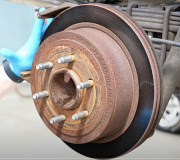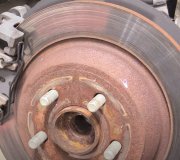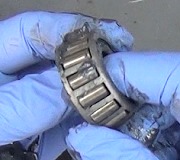You can look up the part numbers for both vehicles on suppliers' web site to see if the same numbers apply to both cars. In this case, I used the Rock Auto site and found both cars use the same rotors and the same pads, but there are a number of variations. Just because the parts fit, there can be some differences that you must avoid. For this reason, don't swap just one rotor. Transplant both rotors so they are matched to each other.
I would not transplant three brake pads. Spring for a set of new ones. Regardless of the quality, price, or advertising claims, all brake linings must have exactly the same coefficient of friction as the original linings to maintain balanced braking front-to-rear that was designed in by the engineers. There is no such thing as a brake pad that grabs better or stops faster. There can be differences in fade resistance and heat tolerance, but those only become variables under unusual or extreme conditions. The cheapest brake pad you can find still has to perform at least as well as the original ones did, and they still have to match the stopping power of the rear linings.
You can also visit any salvage yard to see which parts interchange. They all have multiple large, very expensive books called "Hollander Guides". Those list every part for your car and model year, with a code number. You look that number up in the back half of the book and it will list every car model and year that used that part. There still can be some differences, such as flat or raised hoods, or the designs in the fabric for door panels, that you have to match by eye, but those books will get you started. This is the best choice when you need a list of donor cars to look for in the yard.
When you already have a donor car in question, like you do, the faster choice is to look up that part for both car models, then see if the same part number is listed for both of them. Even this can present problems. When different part numbers are listed, the part could be the same, but it comes with different additional parts. Brake pads area a good example. One model might have needed special anti-rattle clips that weren't used on the other model. You can use the pads from both applications if that is all you need. Another problem is when parts are improved for reliability or to address a common problem, they often get a new part number. This is where the Hollander Guide is the better source, since they don't get involved with part numbers, only applications.
Be aware that all brake linings need time to wear until their surfaces match the microscopic grooves in the drums and rotors. This pertains to any shoe or pad that is placed on the car, whether it's a new pad or is being transplanted from another car. Even if you move the rotor and pads as a set to a different car, you have to treat this as a new installation. It is impossible for the pads to be held to their mounts so they hit the rotor in exactly the same place as on the other car. If the caliper mount is just a few thousandths of an inch higher or lower than on the other car, the pads will not contact the rotor in the same place as before. It can take a good 100 or more miles, with sufficient stops, before the linings will match the grooves in the drum or rotor. That is when you'll have the correct stopping power, and the front-to-rear balance will return.
Before that break-in has occurred, it is going to take more brake pedal pressure to get the car to stop, although that is very hard to feel. While the brakes feel normal to you, that higher pressure is only acting on the areas of the linings that are contacting the drum or rotor. The largest percentage of lining surface is not making contact yet for that first 100 miles, until they wear down to match. It is fairly common for that high pedal pressure to cause the new linings to overheat, resulting in one type of brake fade. I've already had a couple of cars where the brake pedal was still high and hard, like normal, but the car would not stop regardless how hard the brake pedal was pushed. After allowing the brakes to cool down for an hour, normal stopping power returned, and was fine after that. This type of brake fade is caused by "off-gasing", where the binders in the material gives off a gas that gets trapped between the rotor and the linings. It acts the same as if there were hundreds of tiny ball bearings in there. Those binders, which is like a glue that holds the molded material together, can melt and form a coating on the linings. That's what causes glazing, which also reduces braking power. If you have a freshly-machined rotor, as we used to do with every brake job, there will be very aggressive grooves left in it that will grind that glazing off the pads. When this occurs with relatively smooth rotors, such as what you're transplanting, the only way to get that glazing off may be to machine the rotors and lightly sand the linings.
Check out this article too:
https://www.2carpros.com/articles/how-to-replace-front-brake-pads-and-rotors-fwd
You'll still want to do the rest of the brake job that includes proper preparation of the parts. Drag a flat file over the calipers' pistons and the fingers that hold and contact the outer pads. Your goal is not to shine them up. It's just to insure no rust or dirt is on those surfaces that would prevent the pads' backing plates from sitting squarely on them. Those surfaces must be lubricated with special high-temperature brake grease. Pads are going to vibrate; nothing we can do to stop that. The grease reduces that vibration from being transmitted to the calipers where it would be amplified and heard as a loud brake squeal. Also clean the caliper mounts and lubricate them. GM likes to use two bolts for the caliper to slide on. Clean and lubricate them. If the chrome plating is lifted, the bolt must be replaced. Rust pits will form that prevent the caliper from sliding freely. That can result in a brake pull to one side, and / or excessive wear on just one pad.
It's also a good idea to lightly bevel the leading edge of the linings to prevent that "fingernails-on-the-blackboard" squeal. A couple of passes with the flat file will take care of that. My experience has been if you prevent that squeal from occurring during the break-in period, it will continue to not occur after the linings are worn down past that bevel. A lot of the more expensive replacement pads come with a bevel on the edges already to avoid that source of noise.
SPONSORED LINKS
Monday, November 11th, 2019 AT 5:44 PM




